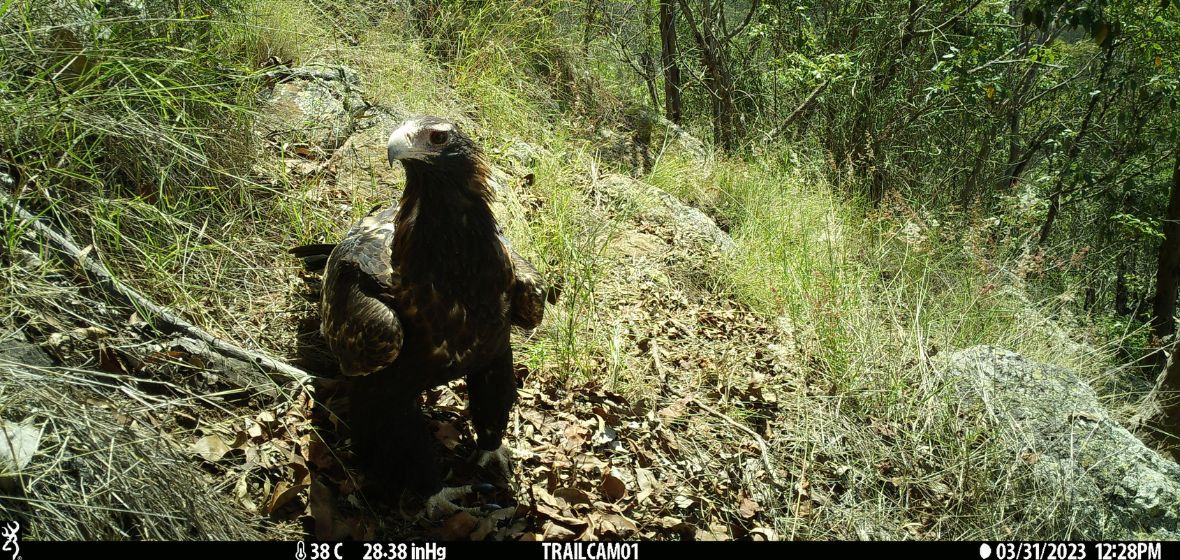
31 January 2024
Wildlife Queensland’s project officer, Hannah Thomas, has uncovered a surprising behaviour in Australia’s largest bird of prey — the majestic wedge-tailed eagle (Aquila audax). These apex predators were caught on camera engaging in a never-before-documented behaviour — sunbathing!
With a wingspan reaching more than two metres, the wedge-tailed eagle is one of the biggest eagles in the world. The species is widespread across Australia, thriving in diverse habitats from rainforests to arid areas. Breeding pairs are monogamous and territorial, and rear one or sometimes two chicks per clutch.
Unexpected observation during brush-tailed rock-wallaby project
Wildlife Queensland’s four-week brush-tailed rock-wallaby observation project took place in the Flinders–Goolman Conservation Estate in South East Queensland, specifically around the slopes of Mount Goolman. Four remote monitoring cameras, strategically placed to capture these elusive marsupials, inadvertently captured the wedge-tailed eagles in a surprising sunbathing session.
Out of 79 images recorded during the study, wedge-tailed eagles were seen basking in the sun on 56 occasions, with some images revealing pairs, including a juvenile. The birds appeared consistently between 9.30 am and 12.30 pm on specific days, often with high temperatures of 28 to 29°C.
“I was amazed to see these images when searching through the cameras for any evidence of brush-tailed rock-wallabies. It was an incredibly lucky find, considering there was no evidence of eagles on any other nearby cameras,” said Hannah.
Publication of newly observed wedge-tailed eagle behaviour
Although studying the wedge-tailed eagles was not part of the brush-tailed rock-wallaby project, Hannah noted the significance of the observation. She could not find previous documentation or photographs of this behaviour for the species in ornithology literature.
Consequently, she collated the information and images and compiled a paper that was recently accepted for publication by the peer-reviewed journal Australian Field Ornithology.


Wedge-tailed eagles sunning on the slopes of Mount Goolman, Flinders–Goolman Conservation Estate, South East Queensland. Pair of adults, March 2023; Adult, March 2023. © Hannah Thomas
Sunbathing controls ectoparasites
This newly observed behaviour provides insights into how eagles may control ectoparasites, as exposure to ultraviolet radiation during sunbathing can benefit bird health.
Birds exposing themselves to solar radiation to manage ectoparasites is not uncommon in the avian world. The act of sunning either kills parasites directly or makes them more vulnerable to preening. Hannah drew parallels with other Australian bird species, such as the Australian magpie and the little eagle, which also exhibit similar sunbathing behaviours.
Importance of comprehensive camera monitoring
Hannah highlighted the importance of thoroughly examining all camera images, even if the primary focus is on a nocturnal species, as the unexpected can often lead to groundbreaking discoveries.
Wildlife Queensland celebrates Hannah Thomas’s discovery, which provides new insights into the behaviours of a key apex predator and encourages further research and conservation efforts.

A wedge-tailed eagle enjoying the sun at Mount Goolman, Flinders–Goolman Conservation Estate, South East Queensland. © Hannah Thomas
Threats to wedge-tailed eagles
The wedge-tailed eagle is currently listed as Least Concern under the Nature Conservation Act 1992. However, the Tasmanian subspecies (Aquila audax fleayi) is listed as Endangered at a federal level under the Environment Protection and Biodiversity Conservation Act 1999.
Australia’s largest flying raptor faces many threats, such as:
- tree-clearing and the loss of nesting sites
- secondary poisoning (e.g., eating rabbits laced with poison)
- collision with overhead wires, fences and vehicles while eating roadkill.
In the past, wedge-tailed eagles were legally killed in large numbers due to the belief they were responsible for killing livestock. However, recent research has shown that the bird’s impact is minimal as they mainly feed on rabbits and carrion, as well as lizards, possums, foxes and feral cats.
Wedge-tailed eagles are protected under the National Parks and Wildlife Act 1975, making it illegal to kill, trap or poison them.
What you can do:
- Learn about wedge-tailed eagles and how to live with them on your property.
- Protect nesting sites from disturbance, especially during the breeding season (typically August-October).
- Report dead or injured eagles to the Queensland Government — 1300 130 372.
Check out Hannah Thomas’s peer-reviewed publication for more details on her fascinating findings.
